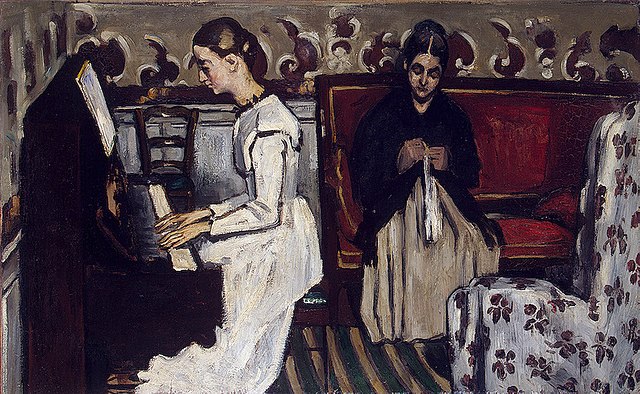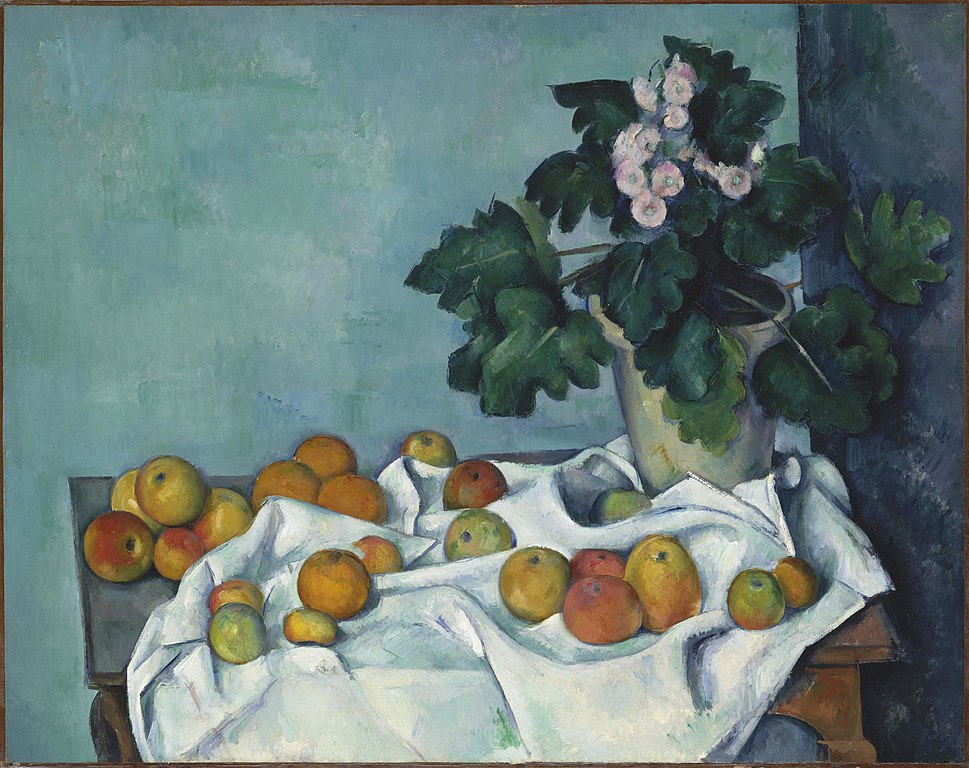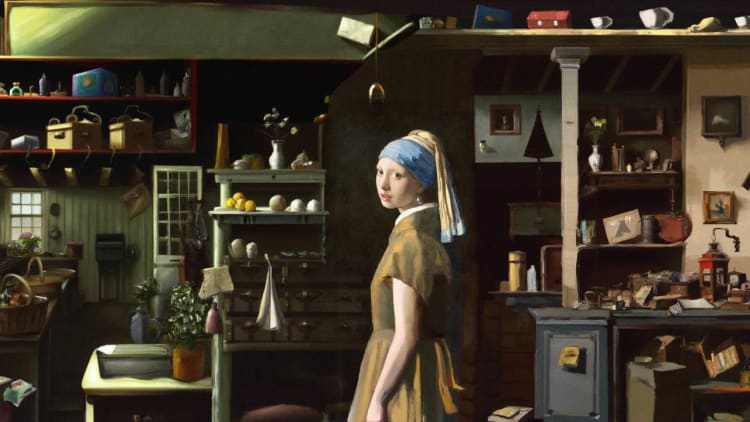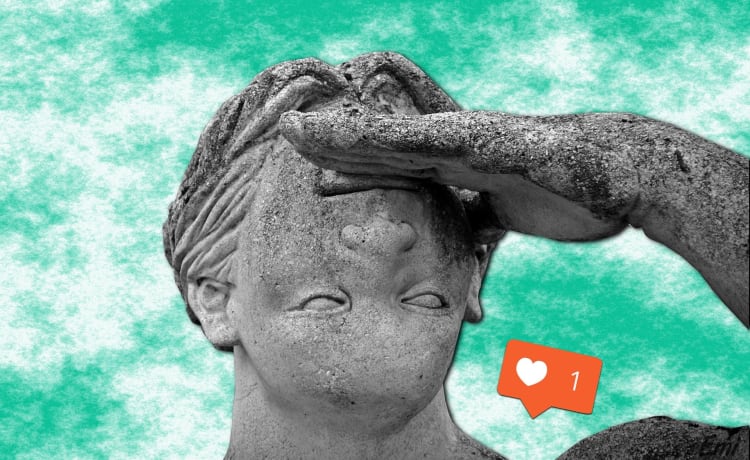Paul Cézanne is considered as the father of modern painting. In less than a century, he has become one of the most important French painters in the art history.
Discover 13 things to know about this painter respected by his contemporaries.

1 - He was born out of wedlock
Paul Cézanne was born in Aix-en-Provence on January 19, 1839, a rare occurrence at the time, his parents were not married at his birth.

The Overture to Tannhauser: The Artist's Mother and Sister, Paul Cézanne, 1868
Louis Auguste Cézanne, his father, was a hatter and his mother, Anne Elisabeth Honorine Aubert, a milliner. They finally got married in 1844.
2 - In college, he was a friend of Émile Zola
Paul Cézanne studied at the Collège Bourbon in Aix-en-Provence and became friends with Émile Zola, but also with Louis Marguery and Jean-Baptiste Baille. This small group of friends was nicknamed "Les Inséparables".

Paul Alexis reading to Émile Zola, Paul Cézanne, 1869-1870
One day, young Paul physically defends his friend Emile Zola in the schoolyard. The next day, Émile offered him a basket of apples as a token of his thanks, and this basket would have a great impact on Cézanne's life as an artist...
3 - Apples became one of his favorite subjects
Paul Cézanne propelled still life painting to almost never reached levels and apples inspired him a lot during his whole life, so we can thank Emile Zola for that.

Still Life with Apples and Pot of Primeroses, Paul Cézanne 1890
Towards the end of his life, he even confided to his friend Joachim Gasquet: "Here! Cézanne's apples, they come from far away!"
4 - He abandoned his law studies
In 1860, he stopped studying law and his father suggested that he work for the Cézanne and Cabassol bank in Aix-en-Provence, of which he was the co-owner and co-founder.

The Seine at the Quai d'Austerlitz, Paul Cézanne, 1876-1878
Finally, the following year, his father agreed that he should leave Provence for Paris.
After failing the entrance exam to the École des Beaux-Arts, Paul Cézanne studied at the Charles Suisse Academy and became a copyist at the Louvre. It was during this period that he met Auguste Renoir, Claude Monet, Alfred Sisley and Camille Pissarro.
5 - He participated in the First Impressionist Exhibition
In 1874, the photographer Nadar's studio in Paris hosted the very first Impressionist exhibition. Paul Cézanne presented three works: A Modern Olympia, The Hanged Man's House and Study, Landscape at Auvers.

A Modern Olympia, Paul Cézanne, 1873-1874
The reception he and his colleagues received was rather negative, some people were even scandalized and did not understand this "crazy" painting. Louis Leroy wrote: "[...] The horrible attracted him: the so badly bleached Blanchisseuse by M. Degas, A modern Olympia by Cézanne... finally the vase overflowed."
Read also: 5 things to know about Impressionism
6 - Cézanne developed a unique working method
Working mainly on the motif, Paul Cézanne drew by a succession of strokes and disjointed lines describing the landscape and objects geometrically and following the aerial perspective.

Rocks at Estaque, Paul Cézanne, 1879-1882
The precision of his painting lies mainly in the degradation of colors by juxtaposed touches, he considered the shadow as a color and generally used blue to accentuate the effect of chiaroscuro.
7 - His father had him build a painting studio in Jas-de-Bouffan

The basin of Jas-de-Bouffan, Paul Cézanne, 1876
In 1881, his beloved father financed the creation of a studio in a residence he had acquired in 1858 in the bastide of Jas-de-Bouffan, west of Aix-en-Provence.
8 - He painted the Mont Sainte-Victoire nearly 80 times
In 1886, Cézanne resided in Gardanne with his small family, and that year he began his famous cycle of paintings on Mount Sainte-Victoire.
He represented this mountain almost 80 times, half of the works are watercolors and the other half are oils on canvas.

The Montagne Sainte-Victoire and the Château Noir du Tholonet, Paul Cézanne, 1904-1906
With this incredible series of paintings, Cézanne shows his vision of painting through the landscapes of his early childhood.
He painted this mountain until his death in 1906. He said: "Painting from nature is not the objective, it is to achieve sensations. It is not a question of painting to copy nature."
9 - Ambroise Vollard becomes his dealer in 1895
The art dealer Ambroise Vollard represented the art of Paul Cézanne, which he offered for sale to his clients in his Parisian gallery.
Quite quickly, the artist's value began to rise and the demand for his paintings became increasingly strong.

Portrait of Ambroise Vollard, Paul Cézanne, 1899
In 1899, Paul Cézanne painted a portrait of his dealer, an oil on canvas that is kept in the collections of the Petit Palais in Paris.
That same year, Ambroise Vollard bought the entire collection of Paul Cézanne's studio, the rest belongs to the history of art...
10 - In 1904, Cézanne sent an interesting letter to Emile Bernard
In a letter dated April 15, 1904, Cézanne advises Emile Bernard to "treat nature by the cylinder, the sphere, the cone, all put in perspective, that is, that each side of an object in a plane is directed towards a central point."

Self-portrait with a vase of flowers, Emile Bernard, 1897
He adds: "The lines parallel to the horizon give the extent, that is to say a section of nature or, if you like better, of the spectacle that the Pater Omnipotens Æterne Deus spreads out before our eyes. The lines perpendicular to this horizon give depth. Now, nature, for us men, is more in depth than on the surface, hence the necessity of introducing into our vibrations of light, represented by the reds and yellows, a sufficient sum of bluish, to make the air feel."
11 - His son was also called Paul Cézanne
Paul Cézanne, the son of the painter of the same name, was born in 1872 from his union with Hortense Fiquet.

The artist's son, Paul, Paul Cézanne, 1885-1890
The son of Paul Cézanne became friends with the son of Auguste Renoir, Jean Renoir. He also collaborated with the latter in the production of his cinematographic works.
12 - He had the will to paint until his death
At the end of his life, the painter suffers from diabetes that causes him violent migraines that at times prevent him from painting, but he does not abandon the discipline that has animated his life, on the contrary, holy Paul!
In 1904, it was the consecration for the painter: an entire room at the Salon d'Automne, of which he was a founding member, was dedicated to him.

Cézanne's room at the 1904 Salon d'Automne, Ambroise Vollard on the right
On October 15, 1906, while painting outdoors in the Sainte-Victoire mountain range, a terrible storm broke out, and the artist felt ill and lay in the rain for several hours.
He was taken home on a stretcher where he died a few days later on October 22, 1906, from the effects of a devastating pneumonia.
13 - One of his paintings was sold for 250 million dollars
Painted in at least five versions, The Card Players are attempts at a genre scene in which we see Provençal horse owners waiting at the Jas-de-Bouffan before taking their animals to the Aix fair.

The Card Players, Paul Cézanne, 1892-1893
One of the five versions was sold in a private sale by the heirs of the Greek shipowning family Embiricos to the royal family of Qatar for approximately $250 million.




